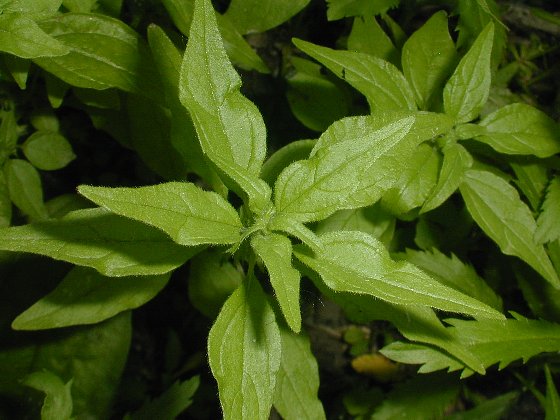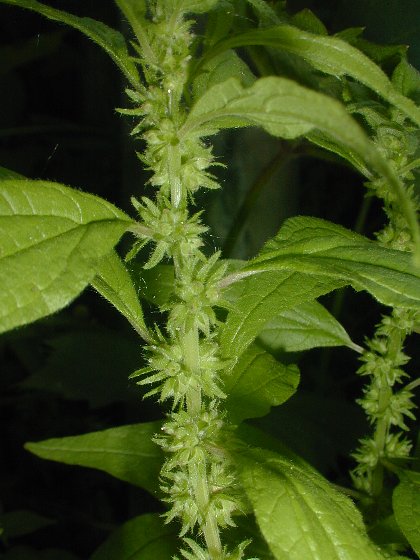Description: This annual plant is about ½–1½' tall and usually unbranched. The central stem is green, 4-angled, and pubescent or hairy. The alternate leaves are up to 3½" long and ¾" across. They are lanceolate, finely pubescent, and smooth or slightly undulate along the margins. Near the base of the upper surface of each leaf, there is a major vein and 2 sides veins that are clearly visible. At the axils of the middle to upper leaves, there are small clusters of bracts and flowers. Each flower is surrounded by several green linear bracts that are hairy or pubescent; these bracts are about 1/6" (4.5 mm.) in length and they are longer than the flowers. The green flowers are staminate (male), pistillate (female), or perfect (male & female). These different kinds of flowers can appear together in the same clusters. All of these flowers have 4 green sepals and no petals. Each staminate flower has 4 stamens, while each female flower has a superior ovary with a style. The perfect flowers have both types of reproductive organs. The blooming period occurs during the summer and lasts about 2-3 months. Cross-pollination of the flowers is by the wind. Each flower with an ovary develops a single ovoid achene. The root system consists of a tuft of fibrous roots. This plant reproduces by reseeding itself and it often forms colonies.

Cultivation:
The
preference is light shade, moist to slightly dry conditions, and a
loamy soil. This species also tolerates partial sun and rocky soil.
Generally, it prefers shaded areas where there is little competition
from other low-growing plants.
Range & Habitat:
The native Pennsylvania Pellitory is a common plant that occurs in most
counties of Illinois (see Distribution
Map). Habitats include mesic deciduous woodlands, savannas
(underneath trees), thickets, limestone glades, areas along
cliff bases, fence rows with woody vegetation, shaded
areas along buildings and stone walls, barren areas underneath yard
trees, and small openings in hedges. This plant occurs in both natural
and disturbed areas.
Faunal Associations:
Information about floral-fauna relationships for this species is
limited. The caterpillars of the butterfly Vanessa atalanta
(Red Admiral) feed on the foliage of Pennsylvania Pellitory and other
members of the Nettle family. The seeds are eaten by Melospiza
lincolnii (Lincoln's Sparrow) during its fall migration
through the eastern prairie region (Martin et al., 1951/1961). There is
some evidence that deer browse on the foliage, as populations of
Pennsylvania Pellitory increased in a savanna after White-Tailed Deer
were removed from this habitat (Bradstreet & Bowles, 2003, p.
48).

Photographic
Location:
Along a stone wall near a back alley in Urbana, Illinois.
Comments:
This inconspicuous little plant is easy to overlook. Notwithstanding
its lack of showy flowers, this species should be included in more
field guides of wildflowers. Pennsylvania Pellitory superficially
resembles some Acalypha spp. from the Spurge
family, but its leaves lack teeth and its flowers are surrounded by
several linear bracts. The flowers of Acalypha spp.
are surrounded by a single lobed bract, and their leaves are serrated
along the margins. Unlike some other members of the Nettle family,
Pennsylvania Pellitory lacks stinging hairs and its foliage is
harmless. It is usually a shorter plant than other members of the
Nettle family, and its leaves are less broad (¾" across or less).